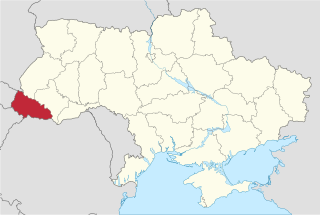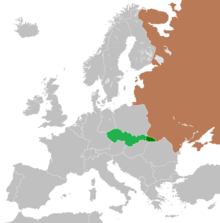
Czechoslovakia was a landlocked country in Central Europe, created in 1918, when it declared its independence from Austria-Hungary. In 1938, after the Munich Agreement, the Sudetenland became part of Nazi Germany, while the country lost further territories to Hungary and Poland. Between 1939 and 1945, the state ceased to exist, as Slovakia proclaimed its independence and Carpathian Ruthenia became part of Hungary, while the German Protectorate of Bohemia and Moravia was proclaimed in the remainder of the Czech Lands. In 1939, after the outbreak of World War II, former Czechoslovak President Edvard Beneš formed a government-in-exile and sought recognition from the Allies.

Ruthenia is an exonym, originally used in Medieval Latin, as one of several terms for Kievan Rus'. It is used to refer to Rus' region, a triangular area which mainly corresponds to the tribe of Polans in Dnieper Ukraine. It is also used to refer to the East Slavic and Eastern Orthodox people of the Grand Duchy of Lithuania and the Kingdom of Poland, and later the Polish-Lithuanian Commonwealth and Austria-Hungary, mainly to Ukrainians and sometimes Belarusians, corresponding to the territories of modern Belarus, Ukraine, Eastern Poland and some of western Russia.

Ruthenian and Ruthene are exonyms of Latin origin, formerly used in Eastern and Central Europe as common ethnonyms for Ukrainians and partially Belarusians, particularly during the late medieval and early modern periods. The Latin term Rutheni was used in medieval sources to describe Eastern Slavs of the Grand Duchy of Lithuania, as an exonym for people of the former Kievan Rus', thus including ancestors of the modern Belarusians, Rusyns and Ukrainians. The use of Ruthenian and related exonyms continued through the early modern period, developing several distinctive meanings, both in terms of their regional scopes and additional religious connotations.
The First Czechoslovak Republic emerged from the collapse of the Austro-Hungarian Empire in October 1918. The new state consisted mostly of territories inhabited by Czechs and Slovaks, but also included areas containing majority populations of other nationalities, particularly Germans (22.95 %), who accounted for more citizens than the state's second state nation of the Slovaks, Hungarians (5.47 %) and Ruthenians (3.39 %). The new state comprised the total of Bohemia whose borders did not coincide with the language border between German and Czech. Despite initially developing effective representative institutions alongside a successful economy, the deteriorating international economic situation in the 1930s gave rise to growing ethnic tensions. The dispute between the Czech and German populations, fanned by the rise of Nazism in neighbouring Germany, resulted in the loss of territory under the terms of the Munich Agreement and subsequent events in the autumn of 1938, bringing about the end of the First Republic.

The military occupation of Czechoslovakia by Nazi Germany began with the German annexation of the Sudetenland in 1938, continued with the creation of the Protectorate of Bohemia and Moravia, and by the end of 1944 extended to all parts of Czechoslovakia.
Transcarpathia is a historical region on the border between Central and Eastern Europe, mostly located in western Ukraine's Zakarpattia Oblast.

Jews settled in this small region variously called Ruthenia, Carpathian Ruthenia, Sub-Carpathian Ruthenia or simply Transcarpathia as early as the 15th century. Local rulers allowed Jewish citizens to own land and practice many trades that were precluded to them in other locations. Jews settled in the region over time and established communities that built great synagogues, schools, printing houses, businesses, and vineyards. By the end of the 19th century there were as many as 150,000 Jews living in the region.

Carpatho-Ukraine or Carpathian Ukraine was an autonomous region, within the Second Czechoslovak Republic, created in December 1938 and renamed from Subcarpathian Rus', whose full administrative and political autonomy had been confirmed by constitutional law of 22 November 1938.

Zakarpattia Oblast, also referred to as simply Zakarpattia or Transcarpathia in English, is an oblast located in the Carpathian Mountains in west Ukraine, mostly coterminous with the historical region of Carpathian Ruthenia. Its administrative centre is the city of Uzhhorod. Other major cities within the oblast include Mukachevo, Khust, Berehove, and Chop, the last of which is home to railroad transport infrastructure.

Rusyns, also known as Carpatho-Rusyns, Ruthenians, or Rusnaks, are an East Slavic ethnic group from the Eastern Carpathians in Central Europe. They speak Rusyn, an East Slavic language variety, treated variously as either a distinct language or a dialect of the Ukrainian language. As traditional adherents of Eastern Christianity, the majority of Rusyns are Eastern Catholics, though a minority of Rusyns practice Eastern Orthodoxy. Rusyns primarily self-identify as a distinct Slavic people and they are recognized as such in Croatia, Hungary, Poland, Romania, Serbia, and Slovakia, where they have official minority status. Alternatively, some identify more closely with their country of residence, while others are a branch of the Ukrainian people.

The First Vienna Award was a treaty signed on 2 November 1938 pursuant to the Vienna Arbitration, which took place at Vienna's Belvedere Palace. The arbitration and award were direct consequences of the previous month's Munich Agreement, which resulted in the partitioning of Czechoslovakia.

The Rt Rev. Avgustyn Ivanovych Monsignor Voloshyn , also known as Augustin Voloshyn, was a Carpatho-Ukrainian politician, teacher, essayist, and Greek Catholic priest of the Mukacheve eparchy in Czechoslovakia.

Carpathian Ruthenia was a region in the easternmost part of Czechoslovakia that became an autonomous region within that country in September 1938. It declared its independence as the "Republic of Carpatho-Ukraine" in 15 March 1939; however, it was occupied and annexed by Hungary the same day. Starting with October 1944, the Soviet Red Army occupied the territory and short period the territory of the region was organised as Transcarpathian Ukraine (1944—1946), until it was incorporated into the Ukrainian Soviet Socialist Republic in 1946. In total, between 1939 and 1944, 80,000 Carpathian Ukrainians perished.

The First Czechoslovak Republic, often colloquially referred to as the First Republic, was the first Czechoslovak state that existed from 1918 to 1938, a union of ethnic Czechs and Slovaks. The country was commonly called Czechoslovakia, a compound of Czech and Slovak; which gradually became the most widely used name for its successor states. It was composed of former territories of Austria-Hungary, inheriting different systems of administration from the formerly Austrian and Hungarian territories.

Maramureș is a historical region in the north of Transylvania, along the upper Tisa River. The territory of the southern part of this region is now in the Maramureș County in northern Romania, whereas its northern section is included in the Zakarpattia Oblast of western Ukraine.

During World War II, the Soviet Union occupied and annexed several countries effectively handed over by Nazi Germany in the secret Molotov–Ribbentrop Pact of 1939. These included the eastern regions of Poland, as well as Latvia, Estonia, Lithuania, part of eastern Finland and eastern Romania. Apart from the Molotov–Ribbentrop Pact and post-war division of Germany, the USSR also occupied and annexed Carpathian Ruthenia from Czechoslovakia in 1945.

The Hungarians in Ukraine number 156,600 people according to the Ukrainian census of 2001 and are the third largest national minority in the country. Hungarians are largely concentrated in the Zakarpattia Oblast, where they form the largest minority at 12.1% of the population. In the area along the Ukrainian border with Hungary, Hungarians form the majority.

The Hutsul Republic was a short-lived state formed in the aftermath of World War I. Inhabited by Hutsuls, the republic was declared on 8 January 1919, when original plans to unite this area with the West Ukrainian People's Republic failed and the territory was occupied by Hungarian police.
Magyaron, also Magyarons , is the name of a Transcarpathian ethno-cultural group, which has an openly Hungarian orientation. They renounced their native language, culture and religion and promoted Magyarization of the Rusyn and Ukrainian population. The Magyarons did not embrace the Ukrainian identity of the Ruthenians in Carpathian Ruthenia but maintained their separate Rusyn identity. From 1920 to 1940, the group promoted the idea of rejoining Subcarpathian Rus' to Hungary, where about 185 000 ethnic Hungarians lived at the time.

The Hungarian invasion of Carpatho-Ukraine was a 1939 military conflict between the Kingdom of Hungary and Carpatho-Ukraine. During the invasion a series of clashes took place between the Hungarian and Polish troops against the paramilitary formations of the Carpathian Sich of Carpathian Ukraine and some Czech troops who remained in the region after the Czechoslovak army was disbanded. The war ended with the occupation and subsequent annexation of the territory of Transcarpathian Ukraine to the Kingdom of Hungary.



















